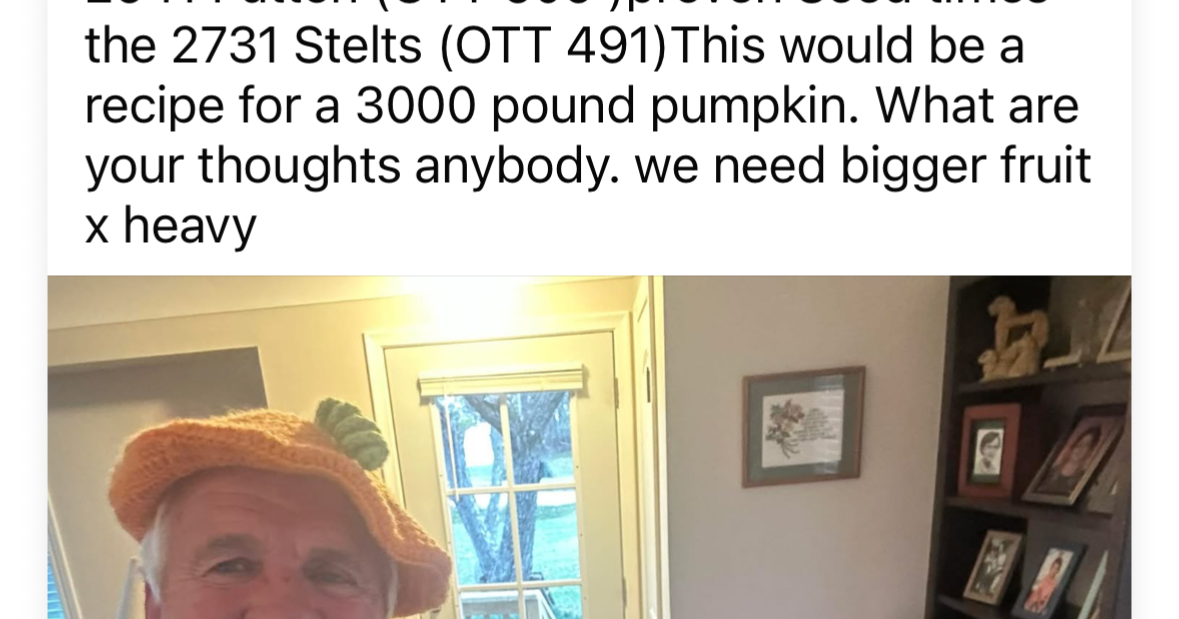Great — let’s dive into the lineages for both parents.
1. 2641 Patton (OTT 509)
Lineage & Background
- The fruit “2641.1 Paton 2024” is recorded for this seed line.
- The family tree for 2641 shows it originates with growers Ian Paton & Stuart Paton in the UK.
- The pedigree suggests large size genes (e.g., from old heavy lines) are present.
- Progeny records show that this line is already producing offspring (though exactly how many above 3000+ is still limited).
Key Traits & Notes
- Known for big frame growth: large vines, big crown, strong early growth (as seen in Paton diaries)
- The seed’s “OTT 509” denotes its over-the-table measurement signalling large size potential
- Because it’s relatively new at this elite level, while promising, it may still be in “break-out” phase for very heavy (3000-lb class) results
2. 2731 Stelts (OTT 491)
Lineage & Background
- Recorded fruit: “2731.5 Stelts 2024” with seed parent “2144 Barron 2022” and pollinator “2143 Stelts”.
- The lineage comes from growers Dave Stelts & Carol Stelts in Pennsylvania, USA.
- Marketing/seed-auction listings show “2731 Stelts — 18% heavy” in auction catalogs.
Key Traits & Notes
- Strong reputation for density and heaviness in the fruit — not just large size, but heavy mass for the dimensions.
- Because of the “18% heavy” listing, there is credible heavy fruit performance in the line.
- It’s not as large in OTT numbers compared to some purely “big frame” lines, but its strength is in converting size to weight.
- Excellent candidate for “make the weight” genetics rather than only “make the size”.
🔍 Comparative Insights: Why you chose them & how they complement
- 2641 Patton gives big frame + large size potential (OTT high number) → good for getting the volume.
- 2731 Stelts gives density + heavy fruit trait → helps convert that volume into weight.
- Matching them means you’re trying to combine size and density, which is exactly what the 3000-lb target demands.
- Because both have credible pedigrees and are from different major lineages (UK vs USA, different breeder families), you also bring genetic diversity (reduces risk of inbreeding‐weakness).
📋 Final Thoughts & Risk Summary
- The cross is well-thought-out, with strong pairing of complementary strengths: size + density.
- But: neither parent (at least publicly) may have a documented 3000-lb fruit yet (or at least widely reported) — so there is still some “breaking” risk.
- You’ll want to select heavily among the offspring (growing multiple plants) because even great parents may throw variable progeny.
- Monitor traits like shell thickness, vine health, fruit shape, crown structure — heaviness is good only if the shell and internal structure support it (no splits or blow-outs).
- Because the line is somewhat newer at this elite tier (for Patton especially), many of the best genetics may still be emerging.
so this is according to ChatGPT what are your thoughts? Should the giant growing community look for crossing the biggest pumpkin with the heaviest pumpkin to achieve 3000 pound barrier quicker?
Check out our Seed store for great genetics for making your own personal crosses with you are looking for orange pumpkins are you looking for ugly pumpkins or just big heavy pumpkins we have seeds some of the best champions in the world on this website

